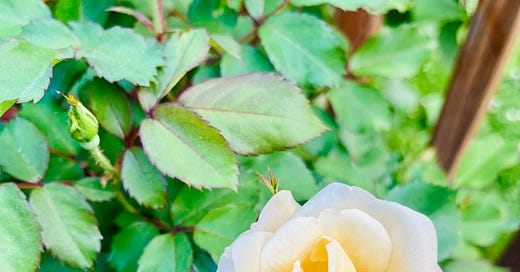Classical Roots is a free weekly newsletter. If you want to support the cause, the best way you can help us is to spread the word.
Between my freshman and sophomore years of college, after a week's misadventuring in London, I lived for a summer on England's Isle of Wight. There is a long and lovely tradition of taking walking tours among the retired community in England—something made possible by their generous public land access laws—and I waited tables and cleaned rooms at a sort of walking toursts' hotel on Freshwater Bay, exploring the Garden Isle by bike and footpath whenever I wasn't on shift.
I think that was the season when I first became aware of June as a palpable personality among the months of the year. My mind was full of passages from Kenneth Grahame's The Wind in the Willows—a book I'd only recently discovered—and it was probably from those pages that I lifted the imagery of the year as a grand pageant, full of personified forces in flowery regalia. Few things are lovelier than June in the English countryside and, on my own in what felt like a far-flung corner of the world, I walked through the kissing gates, along the chalk cliffs, and through dewy fields of cow parsley as if in a dream. June's mildness impressed itself on me again and again--the warm and even days, full of sun without being filled with heat, the migrant birds nuptial and nesting among thatched roofs and lime-coated chimneys, the chalk-white paths unspooling through oak groves and over hills whose cold breezes hinted at the omnipresent sea. It was a season that taught me the primal value of travel and of solitude—of finding places and making space where the world can impress itself on you, and make you a steward of its mysterious, transitory beauty.
June in Massachusetts can't boast that same mildness, but I find its rough edges just about as charming. Apparently, this spring we've endured the longest unbroken stretch of rainy Saturdays in state history, and I seem to be the only one who isn't bothered. Though it's probably false, my prevailing sense that the world is healing from last year's drought, which left this part of the world so parched that we spent November under a haze of wildfires, has made all the rain feel like a balm rather than a blight. It may have thrashed my peonies just as they began to bloom, but it's also filled the rain barrel with generous, cool, clear water in abundance, thickened the grass, and set a bumper crop of fruit on my orchard trees. This June, like that other one long ago, is crowned with flowers, and makes no demands on us but admiration.
June itself might not be demanding, but the garden wants plenty from us this month. Here are a few tasks worth considering
1/ Pinch Dahlias
A generous friend of mine gave me a king's ransom in dahalia tubers this spring, and I've now got something like twenty-six varieties in the ground in our new cutting garden. The first green shoots that appear are always cause for celebration, and it's therefore tempting to leave them alone as they rise, hoping for early flowers. But the wiser thing is to "pinch" them while the first stalk is still fairly low--which teally means cutting the central stalk just above a pair of new leaves. The plant will grow multiple new stalks from this place, rewarding you with thicker blooms.
2/ Fertalize Clematis
Type Three late-blooming clematis vines like my beloved Clematis Perpetua are just about to flower, a fireworks show they will keep up until December in the right conditions. Now is a great moment to fertilize them with liquid seaweed or tomato feed so they have plenty of nutrition to draw on as they bloom.
3/ Pinch Tomato Suckers
Tomatoes are responding to the abundant light and growing heat with a burst of stalk and flower. The branches of tomato plants always split as they grow--a new branch forming in the V between two larger branches. From this point on in the year, it's unlikely that those new shoots with grow large enough to bear fruit before the first frost, so all they do is drain energy and nutrition from the plant. It's got this reason they're called "suckers," and the best practice is to pinch them off--an actual pinch in this case--with a thumbnail whenever you see them forming, thereby directing the plant's full energy to the fruit.
If you enjoy what you’re reading here and want to support us, why not subscribe? It’s free to all and you’ll get access to our weekly posts, as well as a weekly subscriber-exclusive chat where we brag about our gardens and beg for advice. It’s the best way to support us.
Also: Tell me what you think! Your comments are part of what makes this program worth doing and this newsletter worth writing. If you have thoughts, advice, questions, or enthusiasm, let me know! Others are waiting to join the conversation.




Love the imagery...makes me want to have a walk about on the Isle of Wight. Thanks
It would fun to kick that idea around. I'm game.